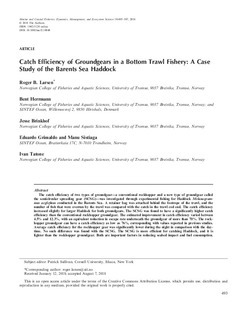Catch Efficiency of Groundgears in a Bottom Trawl Fishery: A Case Study of the Barents Sea Haddock
Larsen, Roger B.; Herrmann, Bent; Brinkhof, Jesse; Grimaldo, Eduardo; Sistiaga, Manu Berrondo; Tatone, Ivan
Journal article, Peer reviewed
Published version
Permanent lenke
http://hdl.handle.net/11250/2567696Utgivelsesdato
2018-10-10Metadata
Vis full innførselSamlinger
- Publikasjoner fra CRIStin - SINTEF Ocean [1387]
- SINTEF Ocean [1461]
Sammendrag
The catch efficiency of two types of groundgear—a conventional rockhopper and a new type of groundgear called the semicircular spreading gear (SCSG)—was investigated through experimental fishing for Haddock Melanogrammus aeglefinus conducted in the Barents Sea. A retainer bag was attached behind the footrope of the trawl, and the number of fish that were overrun by the trawl was compared with the catch in the trawl cod end. The catch efficiency increased slightly for larger Haddock for both groundgears. The SCSG was found to have a significantly higher catch efficiency than the conventional rockhopper groundgear. The estimated improvement in catch efficiency varied between 4.5% and 12.3%, with an equivalent reduction in escape rate underneath the groundgear of more than 70%. The rockhopper groundgear can have a catch efficiency as low as 76%, corresponding with values reported in previous studies. Average catch efficiency for the rockhopper gear was significantly lower during the night in comparison with the daytime. No such difference was found with the SCSG. The SCSG is more efficient for catching Haddock, and it is lighter than the rockhopper groundgear. Both are important factors in reducing seabed impact and fuel consumption. When compared to results of a similar study on Atlantic Cod Gadus morhua, we found that in general, both groundgears had a greater catch efficiency for Haddock, which accords with differences in behavior between the two species.

